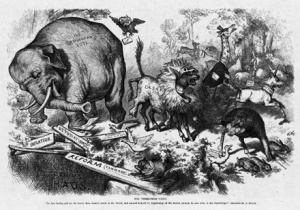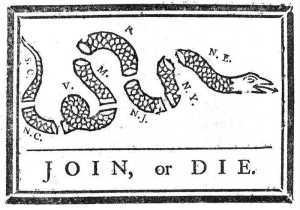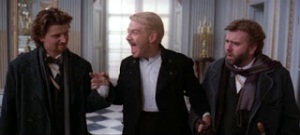In current century, art is a work that young, old, rich, and poor can keep in touch. But in early century, only noble men, sophisticated scholars, and others used art to entertain themselves and communicate with themselves by putting their messages, symbols, and propaganda using art, such as poems, paintings, and etc. These noble men look down on peasants and didn’t want them to understand what noble men was intending to, for art wasn’t familiar to poor peasants. Their intend to place meanings inside art continued until this day, propaganda and things that scholars want to inform is being represented through artwork.
Republican Party sending message using propaganda to attack Democratic Party
단심가 (丹心歌) (poem of single–heartedness)
Type of art in Poem form by Jung, M. to represent his position of political side during Cho-Sun Dynasty, Korea
One of the most famous propaganda made by Ben. Franklin, Join or Die
Dr. Franklin is trying to inform states to join in power and make a solid country.
A word HOPE in graffiti on a wall.
Although it’s illegal to write this type of art on a wall is illegal, this graffiti artist’s message that he wanted to give people was that there always will be hope
Like this, people uses types of arts (painting, drawing, poetic words, spoken words, and etc) to communicate, or not let others to understand. In Hamlet, written by Shakespeare, Hamlet is extremely sophisticated scholar, and a prince of Denmark. He uses his knowledge in literature and verbal abilities to not let others to understand what he is thinking or mocking them.
In act 2 scene 2, Hamlet is having conversations with Polonius.
Hamlet – Excellent well. You are a fishmonger
Polonius – Not I, my lord.
Hamlet – Then I would you were so honest a man
Polonius – Honest, my lord?
Hamlet – Ay, sir. To be honest, as this world goes, is to be one man picked out of ten thousand
Polonius – That’s very true my lord
Hamlet obviously mocked him by describing Polonius as fish seller. Polonius at first strongly rejects Hamlet, but as soon as Hamlet tweaks his statement and says that Polonius is honest as fish seller, Polonius then accepts it. Polonius didn’t get Hamlet’s intelligent verbal usage, and admitted that he be compared with fish seller.
Hamlet and Polonius’s conversation
Continuing on from Act 2 Scene 2, Hamlet meets Rosencrantz and Guildenstern. Hating them so much, Hamlet even describes them as tedious old fools. Throughout the scenes, Hamlet messes around with two men’s statements and thoughts.
Hamlet – (sarcasm, but not expressing it) My excellent good friends! How dost thou, Guildenstern? Ah, Rosencrantz! Good lads, how do you both?
From left: Rosencrantz, Hamlet, and Guildenstern
When artists applied their thoughts using each of their art forms: ie. Cho-sun Dynasty politician’s poetic expression, U.S. politicians’ propaganda to attack or to bring everyone into one, and graffiti artists’ message despite its art being illegal in some ways. Hamlet is delivering his message to others through his sophisticated verbal discussion and sarcasm toward others.





